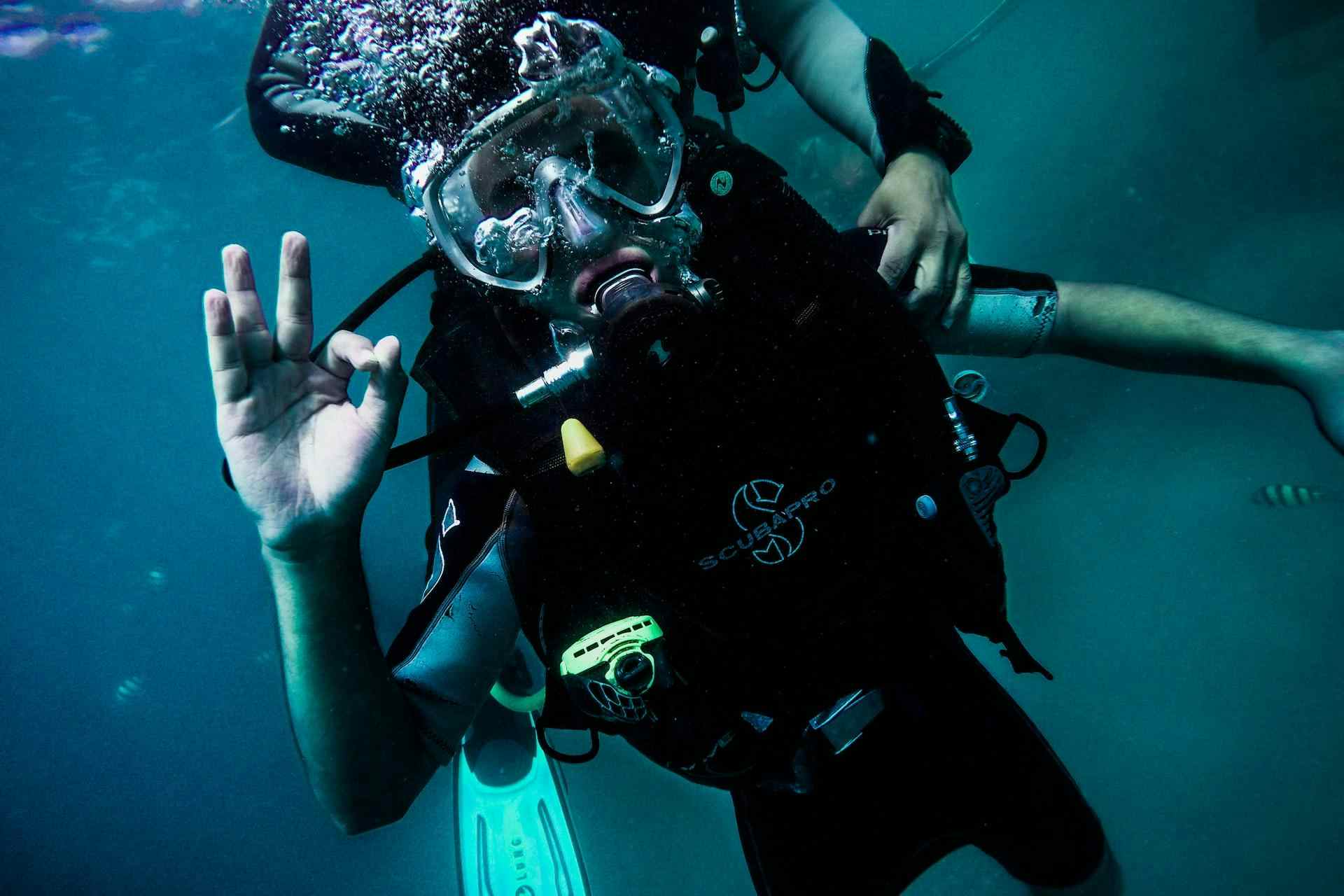You'd be forgiven for thinking that the UK's waters are cold, murky and unremarkable – not suitable for diving, right?
Wrong. Coastal waters here are often cold, sometimes murky, but rarely unremarkable.
In fact, the UK has more shipwrecks per mile of coastline than any other country in the world, and marine biodiversity is superb.
Divers pursuing shipwrecks are at home in the UK’s waters, whereas those after wildlife will find plenty of rare fish, crustaceans, anemones, grey seals and dolphins – not to mention gigantic basking sharks in summer.
So, where are the best places to go scuba diving in the UK?
Before you dive
Before heading for the open water, you must consider your diving experience, skills, gear and any required licences.
You generally don't need a licence to dive recreationally in UK waters. But some marine reserve sites and diving hotspots require you to buy a licence from local diving centres and shops.
However, the rules are strict regarding interfering with wildlife and wreckages. Divers have been arrested for looting, including two who were sentenced to three and a half years in prison for looting a ship in the English Channel.
Always research local and national rules and licensing requirements before heading out.
Scuba diving courses and training
As with diving anywhere, taking part in scuba lessons with PADI-registered instructors is highly recommended unless you're an experienced diver. Consider a refresher course if it has been a while since you've dived.
PADI is a recreational diving membership and diver training organisation that trains instructors to the highest standards.
You can learn to dive in the sea or pools. Some, like the London Diving School, even offer fully-heated training pools for no-stress try dives in a controlled environment. Before exploring the United Kingdom's many underwater worlds, learning about using diving gear, snorkels, and following emergency procedures is essential.
Moreover, some of the UK's diving locations are challenging due to cold temperatures and poor visibility. So unless you're a highly experienced diver, you'll need a guide. They'll also help you determine what gear and diving skills you need, such as wetsuits, drysuits, and deep diving experience.
The best places to dive in the UK
The UK's best diving sites are scattered from north to south and east to west. So whether you're a solo traveller or travel with fellow divers, there’s something for everyone. Scuba dive holidays don’t have to be adventure holidays; there are plenty of warm, calm waters to explore.
Scapa Flow, Orkney Islands
For hiking, diving, cycling and exploring, heading to the Orkney Islands is an excellent idea for an adventurous staycation.
Scapa Flow is a natural harbour sheltered by the Mainland, Graemsay, Burray, South Ronaldsay and Hoy. It was a prolific base for the Royal Navy during both World Wars and is an internationally acclaimed diving spot with incredible wildlife and well-preserved and easily-accessible shipwrecks at shallow depths of less than 10m in some cases.
Several famous wrecks are at Scapa Flow, including the German High Seas Fleet, which was scuttled in 1919. Seven ships from this single encounter, including the SMS Karlsruhe, are accessible to divers today.
Other wreck diving spots include the F2, a German cruiser scuttled in 1940. There are very few places where so many shipwrecks are easily accessible to divers at relatively low depths.
The water at Scapa Flow is cold, and visibility can be limited, so head out with a guide. Luckily, numerous diving shops and centres are nearby, so you'll be in good company. In addition, Scapa Flow takes a long time to explore, which makes it perfect for diving holidays.
St. Abbs Marine Reserve, Scottish Borders
Not far from Berwick-on-Tweed, St. Abbs is a protected marine reserve home to various marine life, including seals, octopuses, lobsters, the menacing-looking wolffish, fantastic anemones and sea toads.
There are several well-known dive sites here, including Cathedral Rock, known for its colourful walls and underwater archways.
Another popular site at St. Abbs is the Wuddy Rocks, a collection of pinnacles home to many species of marine flora and fauna, including several rare fish species.
Though not as famous as St. Abbs, the North Berwick area offers many dive sites just a little further north, including Bass Rock, a small island home to a vast colony of gannets.
Lundy Island, Bristol Channel
Lundy Island is a marine nature reserve located off the coast of Devon, where cooler waters from the Gulf Stream mix with warmer waters from the Mediterranean. With milder temperatures and clear water, Lundy Island has earned a superb reputation in the UK and the global diving scene.
There are several prolific dive sites to explore here, including the wreck of the Robert, a schooner that sank in 1975. Dolphins, porpoises, and friendly seals are also common here.
Other dive trips include the South West Gully, a deep channel home to various fish, and the Rat Island reef, known for its golden kelp, colourful sponges and sea fans.
Basking sharks and large Red bandfish frequent the waters in summer, which is the best time to visit.
Plymouth, Devon
The historic port city of Plymouth is home to several wrecks and dive sites. Some of the most famous reefs in and around Plymouth include Eddy Stone, Tinker Shoal, Hands Deep, Panther Shoal, and Mewstons, and prolific wrecks include James Eagan Layne, the Oregon, the Le Poulmic, HMS Scylla, the Totnes Castle, the Elk, and the Glen Strathallen.
One of the most popular wrecks to explore here is the large frigate HMS Scylla, which was sunk in 2004 to create an artificial reef. She's around 113m long and sits at a depth of just 9m. Viewing how nature has taken over Scylla in a short time is rather magnificent, and it's an enormous and impressive structure.
It's so large that divers entering the wreck can become disorientated if they dive too far into its rooms and corridors, resulting in the deaths of at least four people in the last few years. Therefore, visiting with a trained guide is essential.
Marine life is abundant in the area, especially at the Eddystone Lighthouse reef, home to various fish, crabs and lobsters.
Portland, Dorset
Portland on Dorset’s Jurassic Coast is a popular diving destination with old warships, submarines and dramatic gullies lined with stunning anemones.
One of the most famous wrecks to explore here is the M2, a submarine that sank in 1932. Other wrecks include the Aeolian Sky, which sank in 1979, and the Countess of Erne, a paddle steamer that sank in 1937.
A nearby marine reserve is home to various marine life, including cuttlefish, seahorses, and spider crabs. In addition, rare encounters with bottlenose dolphins are possible.
Farne Islands, Northumberland
The Farne Islands are a group of small, rugged islands located off the coast of Northumberland.
Perhaps most famous for its enormous grey seal population, the Farne Islands are also home to several popular dive sites with some well-known wrecks, including the Somali, a steamship that sank in 1941.
Mark Evans, Editorial Director at Scuba Diver Magazine, told us: "Diving with grey seals is one of the most awe-inspiring things you can do in UK waters, and with most encounters happening in literally just a few metres, whatever your level of certification, you can get up close and personal with these charismatic creatures. Even snorkellers can get in on the action!"
Other sites include the Blue Caps, a collection of underwater pinnacles, and the Longstone Reef, known for its rich and colourful sea anemones and dense kelp forests. The conditions here can be pretty hardcore, but plenty of dive spots exist for all skill levels.
Loch Fyne, Argyll and Bute
Loch Fyne is a sheltered sea loch on the west coast of Scotland. Its relatively clear, calm waters make it an excellent diving spot. There are several wrecks, including the steamship Shuna, which sank in 1913 and is one of the most well-known dive sites in the loch.
Other well-visited dive sites include the Rubha Sron reef, known for colourful soft corals and anemones, and the Ardlamont Point wall, a steep marine wall coated in abundant marine flora. The sheltered waters ensure excellent visibility throughout much of the year.
Seals relax upon the rocks, and basking sharks visit in summer. A quiet, unspoiled diving hotspot.
Scilly Isles, Cornwall
The Scilly Isles are a rich, rugged archipelago with many mild-watered diving sites accessible for much of the year. This is a stunning destination if you're considering travelling in the UK.
There are numerous prolific diving sites across the isles, including the Western Rocks, a significant collection of underwater pinnacles home to a vast range of colourful fish, crustaceans and anemones.
Wreck sites include the Norseman, a cargo ship that sank in 1967, and the Douro, Italia, King Cadwallon, Cita, Minnehaha, Plympton and Hathor.
The topography is breathtaking, with deep gullies, drop-offs, shore dives and steep walls teeming with flora and fauna.
Swanage, Dorset
Swanage is home to several diveable wrecks, including the Fleur de Lys, which sank in 1916 and sits at a comfortable dive depth of 13m.
Other notable sites include the Peveril Ledge, an underwater cliff and series of gullies, and the Old Harry Rocks, a collection of underwater pinnacles. You can visit the old Swanage pier – a classic south coast dive – where you’ll find a myriad of sponges, hydroids, anemones, wrasse, sea bass, crabs, lobsters, cuttlefish and squid.
Scuba diving in the UK
The UK has numerous world-class diving sites rich in marine life, wrecks and geological features.
Many of the most famous wrecks are renowned for being easily accessible at depths of just a few metres. Joining diving groups with trained guides and applying for any necessary licences before planning a dive is essential.








